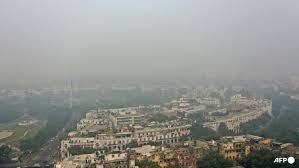Residents of India’s capital New Delhi choked in a blanketing toxic smog on Monday as worsening air pollution surged past 60 times the World Health Organisation’s (WHO) recommended daily maximum.
Levels of PM2.5 pollutants — dangerous cancer-causing micro particles that enter the bloodstream through the lungs — peaked at 907 micrograms per cubic metre on Monday morning, according to IQAir pollution monitors, with a reading above 15 in a 24-hour period considered unhealthy by the WHO.
Individual monitoring stations noted even higher levels — one recorded PM2.5 pollutants at 980, 65 times the WHO maximum.
Because of the worsening toxic smog, India’s capital New Delhi shut schools and switched to online classes until further notice, making it the city’s latest bid to ease the sprawling megacity’s health crisis.
The curbs were put in place by city authorities “in an effort to prevent further deterioration” of the air quality.
Authorities hope by keeping children at home, traffic will be reduced.
“Physical classes shall be discontinued for all students, apart from Class 10 and 12,” Chief Minister Atishi, who uses one name, said in a statement late Sunday.
The government urged children and the elderly, as well as those with lung or heart issues “to stay indoors as much as possible”.
Many in the city cannot afford air filters, nor do they have homes they can effectively seal from the misery of dangerous foul-smelling air.
“The rich ministers and officials can afford to stay indoors, not ordinary people like us,” said rickshaw taxi driver Rinku Kumar, 45.
“Who can even afford an air purifier when paying monthly bills is a challenge?”
On Thursday, toxic smog obscured India’s famed monument to love, the Taj Mahal, as well as Sikhism’s holiest shrine, the Golden Temple in Amritsar, and delayed flights, becoming too thick to see through in several places.
On Wednesday, eight flights were diverted at the Indira Gandhi International Airport in the national capital due to low visibility brought about by a thick layer of smog.
“My eyes have been burning for the last few days”, said rickshaw puller Subodh Kumar, 30.
“Pollution or no pollution, I have to be on the road, where else will I go?” he said, pausing from eating breakfast at a roadside stall.
“We don’t have an option to stay indoors… our livelihood, food, and life — everything is in the open.”
Dense grey and acrid smog smothered the city, with IQAir listing conditions as “hazardous”.
The city is blanketed in poisonous smog each year, primarily blamed on stubble burning by farmers in neighbouring regions to clear their fields for ploughing, as well as factories and traffic fumes.
New Delhi and the surrounding metropolitan area, home to more than 30 million people, consistently tops world rankings for air pollution in winter.
Cooler temperatures and slow-moving winds worsen the situation by trapping deadly pollutants each winter, stretching from mid-October until at least January.
India’s Supreme Court last month ruled that clean air was a fundamental human right, ordering both the central government and state-level authorities to take action.
It is meeting again on Monday to discuss the lack of progress on the health crisis.
—AFP



Leave a Reply